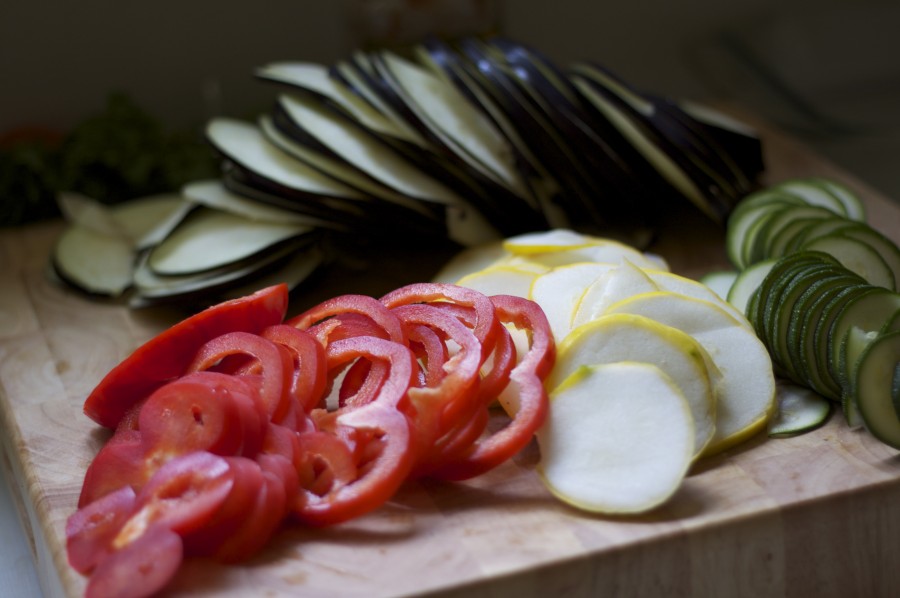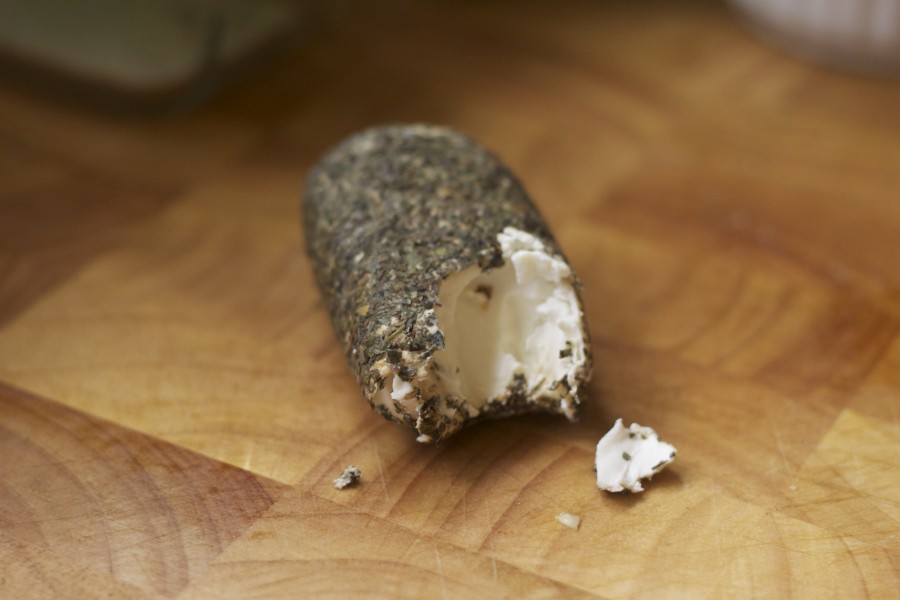loading...
As an academic, English PhD, and food writer, I become increasingly overwhelmed by the little rules and facts that govern recipe writing as a genre.
At first, the recipe seems to be the easiest concept in the world to master: simply record ingredients and say how they’re prepared, right?
Well . . . sort of.
As with anything, rules keep us in our place, they help to avoid confusion, and, most importantly, standardization rules are the one tool any recipe writer can use to ensure a dish is made properly by anyone, anywhere, and at anytime.
[Of course, this idea assumes we all use the same standard written English, but I’ll return to this point in another post.]
I’ve been e-mailing back and forth with my editor at The Advocate, Cheramie, and, thus, re-reading Ostmann and Baker’s Recipe Writer’s Handbook. I’m beginning to go cross-eyed by the dozen or so ways in which “preferred terms” actually determine how a recipe is, or, should be written.
When I first started writing about food, nobody told me that recipes had set rules besides the ones I assumed I understood by regularly reading cookbooks. Moreover, nobody told me that different print mediums—magazines, newspapers, blogs, websites, books—all fall under different style sheets and rules depending on the publisher or market.
[Honestly, sometimes these rules are based purely on personal preference and, other times, they’re based on economics (as with AP).]
Without going too much farther into my own experiences in print (and online) culture, here are “5 Preferred Terms and Standardization Rules Every Food Blogger Should Know.” Bookmark this list and keep it handy for the next time you write about cheese or compile an ingredients list.
5 Preferred Terms and Standardization Rules that Every Food Blogger Should Know:
1.) Cheeses
Pictured: a section of herb-encrusted goat cheese from my Zucchini Almond Pasta Salad with Goat Cheese.
Is it Cheddar? cheddar? Either? Or?
I can’t tell you the world of grief I went through trying to standardize capitalization (and spelling) rules of different cheeses in The Fresh Table: Cooking in Louisiana All Year Round. It wasn’t until I was writing my manuscript that I realized that the worlds of “Brie” and “Roquefort” are an uncertain terrain for food writers and editors alike.
Luckily, Ostmann and Baker offer a list of popular cheeses you (or we) should capitalize.
Here is a select list of cheeses by rule—whether to capitalize or leave lower-case. But, keep in mind, you can add to (or remove from) this list based on the AP Style Guide you’re may be using, or the given context in which you’ll be publishing:
Capitalize –
Asiago, Bel Paesa, Brie, Camembert, Cheddar, Colby, Edam, Emmentaler, Gorgonzola, Gouda, Gruyère, Havarti, Jarlsberg, Limburger, Monterey Jack, Muenster, Parmesan, Parmigiano-Reggiano, Romano, Roquefort, Swiss
Lowercase –
blue (not Blue or Bleu or bleu), chèvre, cottage, cream, feta, fontina, mozzarella, provolone, queso fresco, ricotta
2.) Confectioners’ Sugar
Pictured: a beautiful image of Confectioners’ Sugar-Dusted Cookies from the German blog, prstohvat soli. See original recipe here.
I just had a conversation with Cheramie about this. The apostrophe rule here is a little bit tricky as many writers are want to throw the apostrophe right before the “s.”
In general, I think writers hate to think about the grammar rules governing plural possessives, but the rule stands tall: “confectioners’ sugar” is not only the preferred term, but also the term in which we say, “hey, this is the powder version of sugar (not granulated) used by confectioners.”
It’s confectioners’ sugar.
3.) “frost” versus “defrost”
Pictured: an image of beautifully-infused ice cubes from Lockerz.com (here). I suggest a similar idea in my “Smiling Lemon Drop Ice Cubes” recipe (here).
As a child, my mother would say, “defrost the chicken,” and up until I was in my twenties, I actually used the same term. I guess I always thought it was a colloquial, New England way of communicating how to thaw frozen vegetables and meats, but, according to Ostmann and Baker, it’s wildly inaccurate.
You don’t defrost the chicken because it’s not some object that continually goes from frozen to room temperature (like a freezer). Instead, you thaw the chicken.
However, you do defrost your freezer.
But, the more I look into this style guide, the more I realize it will always be up for debate.
A simple scan of Merriam-Webster reveals the way colloquial terms slowly creep into our lexicon and redefine previous terminology: simply to “release from a frozen state” has become the #1 usage of “defrost” where sample sentences suggest that people will, “defrost the soup” or “defrost the turkey.”
Either way, “thaw” is far more specific if only because it suggests the numerous ways a frozen good changes as it comes to room temperature. “Thawing the chicken” means more than removing the ice, but removing stiffness and/or melting liquids as well as removing trace elements of ice.
4.) Ingredients List: Always Indicate Weight and Size

Pictured: Sliced vegetables for Ratatouille. Don’t just say what you’ll need, but also say how much and what size you’ll need when preparing recipes.
Perhaps the rule I was most oblivious to as a food writer for far too long was the indication of weights and measurements when listing your ingredients.
It seems simple enough to write,
1 egg, or
1 chicken breast, or
1 package cream cheese
Right?
Ahem, NO.
The problem with this system is that as far as measurements go, there’s no idea of how large a chicken breast, egg, or package of cream cheese is. Since these ingredients have a range of sizes (sizes that can affect a recipe’s outcome), they need to be specifically detailed for any kind of cook whether they know most serving sizes of chicken are 3-5 ounces or that a standard package of cream cheese is 8-ounces.
Here’s the rule: always list the package size, can size, breast/fillet or cut size (as with a steak, fish, or chicken), and “piece” size when necessary.
And, when you do indicate size, indicate how much of that size you’ll be using.
Here are some great examples:
1 (8-ounce) package cream cheese, room temperature
1 (4-ounce) fillet tilapia, thawed
1 (1-inch) piece ginger, peeled and pressed (or minced)
1 (12-ounce) package frozen spinach, thawed and drained
1 (14.5-ounce) can chickpeas, drained
Exception to this rule: when writing about “eggs,” the preferred term is usually just “egg” as the ingredient is presumed to be of the large size (variety) unless otherwise specified. When specifying, recipe writers should take organic, brown, and/or size (small, jumbo, extra large) into consideration as necessary.
Other Rule(s): when appropriate, always use accent marks from the original loan word. Jalapeño and chèvre are great examples of this idea.
5.) Ingredients List: First Is Always First

Pictured: an image of old recipe cards written by one of my favorite home cooks, Linda. See some of Linda’s recipes here.
Here’s where things get even trickier when dealing with magazine advertisements and older recipes that don’t live up to modern standards of formatting.
Open an issue of Bon Appétit and find an ad for…say…pot roast. Look at the first ingredient at the top of list? I bet it’s X’s company’s finest roast followed by spices or other ingredients.
These are advertisements *disguised* as recipes, and you’ll always notice the company’s product is the first ingredient listed at the top. However, this doesn’t, necessarily, make sense. When writing a recipe, I’ve repeatedly been told by my book, magazine, and newspaper editors that the first ingredient should be the first one you use, not the most expensive ingredient, nor the largest cut of meat.
These are just 5 useful tips any recipe writer (blogger, columnist, cookbook author) should at least know.
And, I’ll continue to add to this list as a way to keep Clearly Delicious readers informed about the ways in which grammar, punctuation (all hail the Oxford comma!), capitalization, and seemingly intuitive structures determine the clarity of our writings for readers.
I can’t wait to share what the new interns discover as they work their way through the CD recipe archives…or maybe I can. No one likes to admit their lack of punctuation or spell check, but it’s always important to review, revise, and rewrite when errors do occur.
Why?
Well, it makes for clearer recipes wherever your kitchen may be. And, for an idea of what we’re finding, see the Intern’s Blog (here).
—
Follow me on Pinterest: http://pinterest.com/helana/
Twitter: https://twitter.com/DancesWLobsters
Facebook: https://www.facebook.com/pages/Clearly-Delicious/103136413059101
Tumblr: http://clearlydelicious.tumblr.com/
Instagram: http://instagram.com/helanabrigman
Lessons in Language: 5 “Preferred” Terms for Recipe Writers,




1 Comment
Ed
September 28, 2017 at 7:46 pmThank you! We are somewhat kindred spirits. “Confectioners'” brought me to your site. I most certainly agree with the order of ingredients. Next, we need to work on “divided” ingredients! Those 1 1/2 cups granulated sugar, divided are better presented as 1 cup granulated sugar at the point in the recipe where it’s needed and the other 1/2 cup where it’s needed.
I think this is especially important when we are trying to ensure that the person using our recipe has a reasonable chance of success. Carry on.